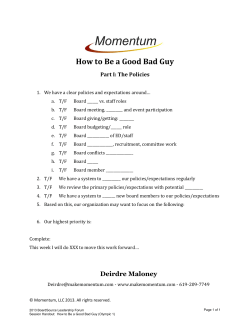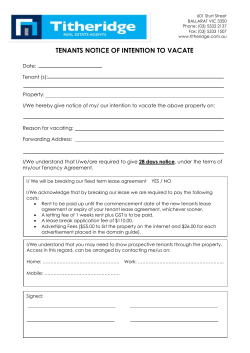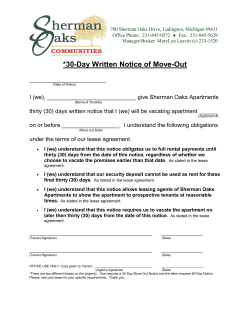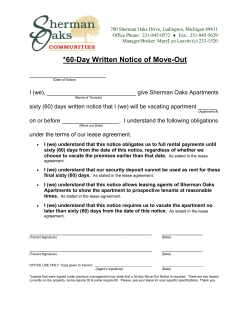
How to Alleviate your Budgeting and Forecasting Pain OVERVIEW
How to Alleviate your Budgeting and Forecasting Pain WRITTEN BY: Deeann Hauser Vice President Product Adoption, Cougar Software __________________________________________________ OVERVIEW Although great headway has been made in automating Commercial Real Estate (CRE) business processes, one area that continues to cause major pain is budgeting and forecasting. Every CRE company, irrespective of its size, understands the mission critical role that budgeting and forecasting plays in managing performance, driving business value and instilling investor confidence. Due to its reliance on manual processes and the general lack of consistent administrative processes, budgeting and forecasting in the CRE world has lagged behind many other business functions. The geographic dispersal of constant contributors to the budgeting process has often worked against the effectiveness of personnel in producing accurate budgets and forecasts. In order to maximize property returns and manage growth, there is additional pressure on CRE professionals to deal with an increase in the need for more frequent and more accurate budgets and forecasts. At the same time data integrity is expected to be preserved. Many CRE companies today believe that their budgeting process is far too costly, a major resource drain and takes too long. ____________________________________________________________________________ answers@cougarsoftware.com 1.877.760.7688 TODAY’S REQUIREMENTS AND CONSTRAINTS Longer Terms and More Frequent Reforecasts One of the biggest trends facing CRE budgeting today is the move towards longer budgets. Three years out has now become the new standard, and even longer term forecasts are becoming a requirement. Also, the number of reforecasts has increased significantly. In the past a single annual budget was the norm. Now quarterly reforecasts are becoming common, and in some cases monthly reforecasts are required. Unfortunately the tools and the technology in use within many CRE environments have not kept pace with these demands. The lengthy time and onerous process, as well as burdensome tools, make meeting the demands of increased terms and frequency almost impossible. Systems and Process Disconnects Existing systems in place are often disconnected from each other. Property management systems are being used to bill tenants, monitor arrears and the terms and conditions of leases. Financial systems are being used to produce monthly financials, track accounts payable and receivables. One type of system is tenant focused and the other is chart of account focused. Any budgets resulting from the financial system tend to reflect a “static point in time” business plan. So they can never be leveraged to do any kind of revisions from a re-forecast perspective. To achieve the levels of budgeting and forecasting analysis at the individual property level, many CRE organisations have to resort to separate off-system processes that heavily utilize spread sheets and similar tools. It is a huge effort to rekey and produce an ever increasing number of workbooks. Also, there is the risk of rekeying errors potentially affecting the accuracy and the reliability of forecasted numbers. Into this already compressed cycle is the need to run multiple “what-if” scenarios. A lot of analysis goes into the strategy behind building a business plan, with the ultimate goal always being to optimize occupancy, revenue and the value of the property. Once the off-system analysis is complete, the results must be reconstituted back into the mainstream systems, consolidated and passed back up to higher levels of corporate authority for review. The impact on the overall portfolio of the individual property budgets and forecasts can now be assessed. About The Author: Deeann has over 20 years of real estate experience in accounting, property management, and real estate software roles. She has deep domain experience – in budgeting, forecasting and valuations and serves as a budgeting/forecasting and Cougar subject matter expert. Deeann has a unique combination of business knowledge and technical skills with a specialty in integrated solutions that link accounting and property management systems with budget/forecasting/fund consolidation tools. She has combined industry specific product knowledge (including Cougar Version 8, Cougar 2006, DYNA, RealmBudget, ARGUS and CTI) with extensive proven track record in Project Management and as a result; to date, Deeann has successfully implemented integrated software solutions in this space at more than fifteen major real estate organizations worldwide. Deeann can be reached at deeann.hauser@cougarsoftware.com ___________________________________________ p2 WHITEPAPER > How to Alleviate your Budgeting and Forecasting Pain MEETING THE CHALLENGES A best of breed budgeting and forecasting solution should be able to add value and alleviate most of the challenges and pains surrounding the business processes. All CRE companies face the same four areas of concern when budgeting. To be able to budget effectively at both the property and consolidated portfolio levels, the following four areas must be evaluated and analyzed: 1. The physical inventory and physical space — evaluate the current in place rent roll, make decisions about those tenants: 2. The vacancies: tenant, curb appeal, comparable CAM (Common Area Maintenance) rates passed onto tenants 3. The Capital Spend — determine a three to five year Capital plan 4. Operating Expenses (OPEX) — determine operating expenditure per property at a very detailed level per account ____________________________________________________________________________ BUDGETING BEST PRACTICES The ideal Budgeting and Forecasting solution should contain most, if not all of the following components and business process best practices: Multiple Version Comparisons A good budgeting solution should be able to compare multiple versions of the same budget, with various "what-if" scenarios. For example: the first version might be an optimal lease up, and the second version might exclude the lease up of a major space that is going to generate the most revenue. Comparing the impact of these two versions, allows one to make realistic decisions. Long Term Budgeting and Multiple Forecasts CRE companies should be able to achieve a one to two to three year budget, with potentially a three to five year Capital plan. To cater for unpredictable events and emerging opportunities, quarterly re-forecasting should be provided at a minimum. Greater frequencies such as monthly reforecasts may become a future requirement. Consolidation and Information Flow in Multiple Directions Being able to roll up and consolidate to higher levels and drill back down is essential. Budgeting and reporting at any level of the corporate hierarchy provides a level of detail and granularity to meet a variety of users requirements and allows for the running of various “what-if” scenarios. p3 WHITEPAPER > How to Alleviate your Budgeting and Forecasting Pain Powerful and Flexible Reporting and Drill Down Inquiries Different types of powerful inquiry and reporting should be standard including: Income), or Total Occupancy across a portfolio, or drill down to a list by property style property generating out of the total revenue for the portfolio reporting. For example: Old Navy and The Gap, are owned by the same company The Gap Inc. – The ability to define a standard report deck saves time – ensuring that the same standard dates are used for every property that that deck is run for. Also export capabilities to excel or pdf should be standard. All generated reports should be able to be extracted to an existing property management system using templates that it would be able to interpret. Single Source of Entry With a single point of entry there is no reliance on external workbooks. Everything that is needed is available within the same system from the most detailed level all the way up to the consolidated level. Rekeying and version issues of data cease to become an issue. Even lease pertinent detailed information should be stored, thereby removing the need to refer to the actual paper document unless terms are changed or the lease is renewed. Also, full chart of accounts level integration with existing accounting systems is a must. Capital Plan by Type of Work To enhance usability and improve user friendliness, capital planning by the type of work that is envisioned, rather than by the actual account, is very helpful to property managers. For example, planning by type of work like a “roof replacement” in year 1 and an “elevator and lobby renovation” in year 2 - rather than planning around account #1000 (building improvements) and then trying to find a creative way denoting what those dollars refer to. Capital Spend Prioritisation Being able to prioritize capital spend at the lower level helps the capital review process. When the seniors go through the approval process, looking at total capital spend, they will understand all the priorities at the property level. In addition reports across the portfolio should allow users various ways to analyze capital spend by priority, by property or by type of work. Recovery, % Rent and Billable Charges Expense recovery functionality should be included. Also % Rent in Tenant Sales capability is required if the property is retail. However, the expectation should not be that every lease should support it. Client or billable charges should also be correctly reflected by producing the journal entry based on the client's chart of accounts. The revenue can then be posted to the correct account. p4 WHITEPAPER > How to Alleviate your Budgeting and Forecasting Pain Automation of System-wide Calculations and Actions The ability to automate certain calculations is a big time saver and can reduce human error. For example, the management fee (set at the property level), can be calculated automatically every time a lease up assumption change is made. Repetitive actions like lease renewals that are merely copies of the previous lease agreement should be fully automated. For example: if an existing tenant is going to renew, a “renew tenant” button should be clicked. That existing lease is then automatically copied, and the changes reflecting the new term pasted (the start date and end date) based on the revisions made in that action. Ad Hoc Portfolio Creation Property managers appreciate the ability to create ad hoc portfolios that reflect only their properties. Ad hoc portfolios offer the following advantages: 1. An ad hoc portfolio gives the property manager a greater understanding of the performance of the properties they are responsible for 2. The noise of what everybody else is doing is removed, so that the manager can zero in on only their properties 3. Ad hoc portfolios by property type can be created, making comparative performance reporting easier for the property manager. For example: office VS retail Detailed Account Break Down Every property manager requires a further break down of detail below the account level. This may be termed "detail support per account". This level of detail is not important for the budget review process, but gives the property manager greater insight into his budget. For example: a property manager may want to model more detail for his purposes, like splitting cleaning into cleaning supplies, cleaning salaries and cleaning uniforms. Security and Audit Budget users need to be limited to only those areas of the business in which they directly participate or are responsible for. Security should therefore be constructed based on each job role and user access limited based on the job role they perform. Every record should have an audit stamp, reflecting any and all changes made to data in the system. The name of the user who made the change, the date and the time that the change was made should all be recorded. ____________________________________________________________________________ SUMMARY The pace of change today has changed the way annual budgets control and shepherd corporate spending. Agility and responsiveness to unfolding events and opportunities have replaced the rigidity imposed by the annual budgeting cycle. The implementation of a budgeting and forecast solution dramatically increases the effectiveness and efficiency of the entire budgeting and forecasting process. As a result, CRE companies are able to make decisions faster and reforecast more often with greater granularity and accuracy. About Cougar Software Founded in 1992 and serving clients worldwide, Cougar Software provides the only financial modeling solutions real estate investors need for budgeting, planning and forecasting. Cougar counts among its customers several of the world’s leading property management and investment companies, pension plans and REITs. p5 WHITEPAPER > How to Alleviate your Budgeting and Forecasting Pain
© Copyright 2025





















